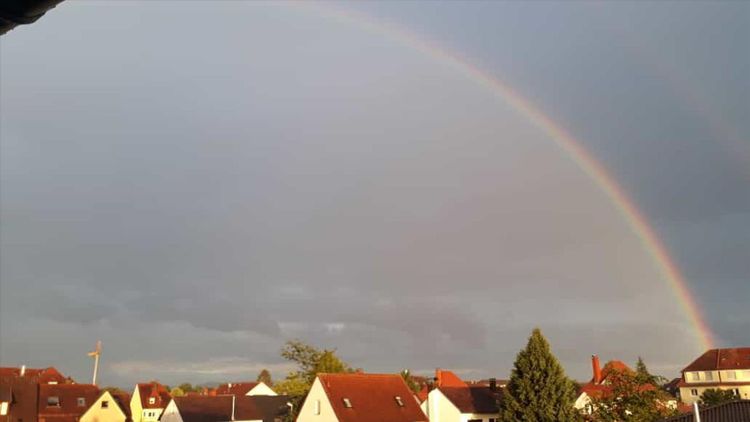The origin of a rainbow can be answered by almost everyone. We learn the physics behind a rainbow very early in our lives, but the phenomenon responsible for it does not linger in the minds of everyone: the refraction of light. It is thanks to light refraction, that a spoon dipped in a glass of water appears as broken.
Refraction
Light can be described either as an electromagnetic wave or as light particles, also called photons, which propagate in space. When light moves across an interface from one medium, for example air, to another medium, for example water, light can be refracted. This means that the speed, more precisely the phase speed, of the travelling light wave changes from one medium to another.
This happens because the different media, air, water, glass, metal, consist of different atoms that are arranged differently and thus have a different material structure. This leads to a very important optical property of materials: the refractive index. The speed at which light moves in a medium depends on the refractive index. The larger the refractive index, the lower the speed in the medium.
Therefore, if a light wave from air, whose refractive index is approximately 1, enters water, which has a refractive index of 1.33, the light will travel slower and its propagation direction will change abruptly. This leads to this optical kink observed when immersing a spoon in water. The change in the propagation direction can be determined very precisely using Snellius' law.

Light dispersion and the rainbow
Light consists of waves with different wavelengths that correspond to different colours in the visible range. The visible range of light is very small compared to the complete light spectrum. It lies between approximately 400 to 800 nanometers (1 nm = 0.0000001 cm), which corresponds to red and to violet. Wavelengths smaller than 400 nm belong to the ultra-violet range and can be used for water and food disinfection. Wavelengths larger than 800 nm belong to the infrared range, which is used in telecommunications and infrared imaging cameras. The picture below, which has been hanging in my office since I moved in, shows the light spectrum.
The speed at which light propagates depends on the wavelength. This phenomenon is known as dispersion and means that different wavelengths also travel at different speeds: the larger the wavelength, the faster the light wave travels in a medium. Since the refractive index of a material determines the speed of light and at the same time the speed depends on the wavelength, the refractive index also depends on the wavelength. This means that red light is refracted more weakly than blue light. Thus, when a white light beam enters a prism, it is refracted at the interface and the different wavelengths propagate at different speeds. When the light exits the prism, it is refracted again and this causes the light to fan out into its different colour components. The same happens when the sunlight falls on a drop of water. This creates a rainbow. Inside the raindrop the light is reflected one or more times before it exits. This leads to the fact that one can often see a double rainbow.

And beyond
There are materials that have different refractive indices along two different directions, more precisely crystal directions. These materials are birefringent, meaning that the speed of light in the material depends on the direction along which it moves. In some materials, external pressure can change the atomic structure and produce birefringence. Furthermore, so-called metamaterials with a negative refractive index can be used to develop invisible cloaks.
Light refraction is an everyday phenomenon that has several applications in science and technology. In particular, the refractive index is used in lenses manufacturing. But it is also used to determine the concentration of some substances in solutions, such as sugar in water. In our laboratory, we use reflectometry for real-time measurements of the layer thickness during the fabrication of thin (about hundreds of nanometers) gallium nitride films by metal organic gas phase epitaxy. The reflected light, which contains information about the refractive index of the layers, is also used to identify the chemical composition of the thin films. A similar principle can be applied to determine surface roughness in the nanometer range of industrial coatings.
Light can be refracted, bent or rotated in a material, creating wonderful optical illusions and effects in everyday life that we can observe and, thanks to physics, also understand. (Andrea Navarro-Quezada, 8.7.2020)
More articles in this blog